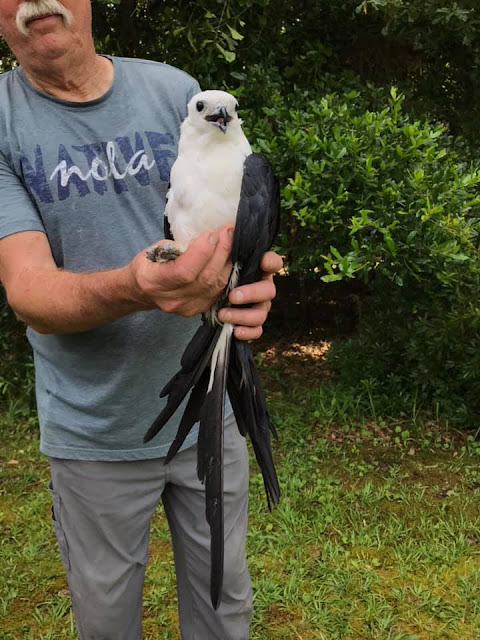 |
| Left to right: Grace Campbell (ARCI, volunteer), Ken Meyer (ARCI), Larry Woodward (Lower Suwannee National Wildlife Refuge, and Jeff Gleason (U.S. Fish and Wildlife Service). |
ARCI has some exciting news to share! With the generosity of many wonderful partners, both old and new, we were able to deploy GPS-equipped cell-phone transmitters on four breeding adult Swallow-tailed Kites, and our colleague Dr. Jennifer Coulson, President of Orleans Audubon, tagged an additional kite in Louisiana!
This brings our fleet of remotely-tracked Swallow-tailed Kites to 16 across the southeastern United States. We are grateful to all the organizations and individuals who make it possible to continue our long-term research to understand the ecology and conservation needs of Swallow-tailed Kites.
Each tagged kite will produce an enormous amount of highly-accurate, time-stratified, and unbiased location data that can be used to address many of the most important questions about the species’ conservation biology, including:
- nesting locations
- home-range and core activity areas
- pre-migration communal roost sites
- timing of seasonal movements
- migration corridors and habitats
- site fidelity
- exposure to potential natural and anthropogenic threats (e.g., severe weather, climate change, drought, habitat loss and degradation, contaminants)
By using the kites’ data to answer the above questions, we can directly shape science-based management, conservation, and policy for this spectacular species. These data will enable local land managers to identify important nesting, roosting, and foraging locations for Swallow-tailed Kites in their respective management areas. There’s an added benefit as well – managing for kites creates an “umbrella effect” where the plants and animals using the same habitats as the kites flourish too.
Let’s introduce you to our Class of 2019:
Suwannee
 |
| ARCI’s Ken Meyer and Gina Kent remove Suwannee from the mist-net. Photo by Nan Soistman. |
Suwannee, a male, comes from a fantastic landscape for nesting Swallow-tailed Kites – the Lower Suwannee National Wildlife Refuge in Dixie County, Florida. We are grateful to the Friends of the Lower Suwannee NWR and the National Audubon Society for provided all the funding needed to track Suwannee. We were joined by Nan Soistman from Sunrise Wildlife Rehabilitation and Einstein, their educational Great Horned Owl. Suwannee’s tracking story will be featured in upcoming publications in the international online conservation magazines National Audubon and bioGraphic (California Academy of Sciences).
Sanibel
 |
| ARCI’s Ken Meyer and Gina Kent fit Sanibel with a GPS-equipped cell phone (GSM) transmitter. Photo by Janet and Aaron Kirk. |
Tracking a kite nesting on an island is a first for us! Quick action, cooperation among old friends from several outstanding organizations, and a lot of love-of-kites made the tagging of this kite possible. Sanibel was captured on Sanibel Island in Lee County, Florida, thanks to the skilled assistance, logistical support, and land access by the Sanibel Captiva Conservation Foundation (SCCF). We were joined by Bre Frankel and Great Horned Owl, Mina, of the Clinic for the Rehabilitation of Wildlife, Inc. (CROW)
The San-Cap Audubon Society is graciously funding Sanibel’s transmitter and tracking data in memory of their late president and dear friend of Sanibel conservation and ARCI, Mr. Jim Griffith.
Palm Beach County Environmental Resource Management (PBC-ERM) Female
Palm Beach County Environmental Resource Management (PBC-ERM) Male
 |
| Melissa Tolbert (PBC-ERM) prepares to release PCB-ERM Male. Photo by Mike Rogers. |
These birds are the first representatives from Palm Beach County, Florida! A big thanks to Margo McKnight and the Palm Beach Zoo for generously funding these two kites. We also thank Melissa Tolbert and David Witmer of the Palm Beach County Environmental Resource Management team for nest finding, monitoring, permission and logistical support. Nicole Jones with the Avian Reconditioning Center (ARC) and Gordon, ARC’s Great Horned Owl, were there for our first capture. For our second capture, we were joined by Callie Coxon and Hino the owl from the Palm Beach Zoo.
Further thanks to Carol and Scott McCorkle and Bill Hammer of Avian Recondition Center (ARC) for additional Swallow-tailed Kite trapping attempts at the Tosohatchee Wildlife Management Area, another area we would like to target for kite-tracking.
Ponchitolawa
 |
| Tom Coulson holds Ponchitolawa. |
This adult male Swallow-tailed Kite was captured near Covington, Louisiana, by our colleague and dear friend Jennifer Coulson, Orleans Audubon Society, and her husband, Tom (pictured). Dr. Coulson shares Ponchitolawa’s data with us (along with Bayou Vincent, Lacombe, and Hobolichitto Creek) as part of a long standing (over 20 years!) and cherished collaboration between she and ARCI.
The Coulson’s rigorous research has contributed greatly to everyone’s understanding of kite conservation biology and management needs, including continuous monitoring of threats and population changes.
 |
| PCB-ERM Female flies away after release. |
Wishing all the Swallow-tailed Kites a safe migration full of plentiful food sources!

Leave a Reply